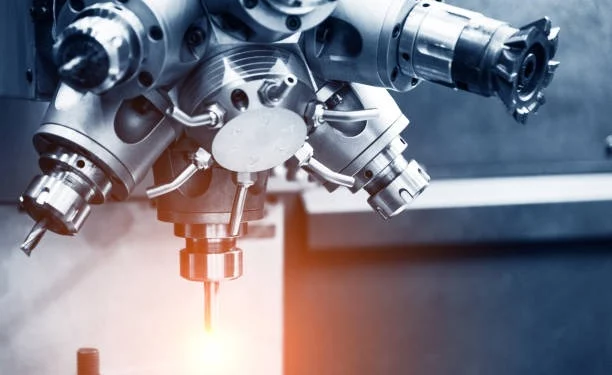What Drives the Demand for Precision Machining?
Precision machining is crucial for producing intricate components in various industries, including aerospace, medical, tech, and electronics. Advanced aircraft, satellites, pacemakers, implants, and surgical tools require sub-millimeter tolerances and absolute consistency. Accuracy is not only preferred but also required by regulatory standards. Precision solutions are also needed for compact circuit boards and housings.
Diverse material demands add to this complexity. Modern manufacturers need the flexibility to work with stainless steel, titanium, plastic polymers, and exotic alloys while delivering repeatable quality. Advanced manufacturing methods like CNC turning respond to these demands for increased accuracy, speed, and adaptability. As industries push boundaries and customers expect shorter lead times and more product customization, precision machining remains critical for any operation looking to stay competitive.
Automation and Robotics: Changing the Machining Landscape
Automation is rapidly transforming the machining industry, with traditional manual machines being replaced by advanced CNC equipment that operates around the clock with minimal human intervention. Robots assist in tasks like tool changing, material handling, and quality inspection, reducing repetitive strain on human workers and freeing up skilled machinists for more complex tasks. This migration offers benefits like greater consistency, higher throughput, and fewer variable costs due to human error. Companies adopting robotics and intelligent automation report efficiency gains, operational cost savings, and the ability to take on new product lines.
Material Innovation: Beyond Steel and Aluminum
The machining landscape has expanded beyond traditional steel and aluminum materials, with engineers and product designers increasingly using cutting-edge materials like carbon fiber composites, ceramics, and high-strength titanium alloys. These materials offer specialized properties, such as lightweight strength and heat resistance, which can improve product performance. However, machining these materials presents unique challenges, such as brittle ceramics, abrasive composites, and titanium alloys. Manufacturers must invest in new equipment, upgraded tooling, and ongoing workforce training to remain viable.
Digital Transformation and Smart Factories
Digital transformation is the next leap in manufacturing efficiency and precision. Smart factories—often referred to as “Industry 4.0” environments—are taking shape everywhere, powered by Internet-connected equipment, sophisticated sensors, and robust software solutions. Within these spaces, machining equipment no longer operates in isolation. Instead, machines connect to a central hub, constantly transmitting performance data, tooling wear, temperature, and other metrics.
This unprecedented access to live data enables a shift from reactive to predictive maintenance, allowing shop managers to address issues before they become costly problems. Digital twins—virtual models of entire machining processes—enable teams to simulate workflows, optimize paths, and spot inefficiencies before they disrupt the shop floor.
Environmental Considerations in Modern Machining
Sustainability is becoming a major focus for machining operations around the world. Many shops now implement closed-loop coolant and lubricant recycling systems, sharply reducing fluid waste and cutting disposal expenses. Innovations in filtration and reclamation have made it easier to recover metal shavings—an important environmental initiative, as metals are energy-intensive to mine and highly recyclable.
Environmental considerations go beyond material recycling. Shops are making strides in adopting energy-efficient practices by installing LED lighting, opting for high-efficiency motors, and closely monitoring resource use. Investments in lean manufacturing and near-net-shape approaches mean less waste is generated in the first place. Some shops experiment with biodegradable or low-toxicity coolants to meet increasingly strict environmental regulations and appeal to environmentally conscious clients. These strategies don’t just help the planet—they often add efficiency, reputation, and long-term cost savings.
Skilled Workforce: Adapting to New Technologies
The evolving nature of machining has altered the workforce landscape dramatically. Skilled machinists are tasked with learning new programming languages for CNC machines, managing integrated automation, and troubleshooting digital networks and communication protocols. The industry recognizes that a blend of craftsmanship, analytical thinking, and computer literacy now defines the modern machinist.
To bridge the skills gap, manufacturers increasingly partner with technical colleges and vocational schools to develop custom curricula centered on contemporary tools and real-world manufacturing environments. Apprenticeship programs are making a comeback, offering hands-on experience while ensuring that the next generation of professionals is prepared to operate, diagnose, and optimize the latest machinery. Lifelong learning is a necessity, not an option, as tools and technologies continue to evolve.
Global Supply Chains and Local Manufacturing
Recent global events have exposed weaknesses in extended supply chains, prompting many companies to re-examine where and how their machining is done. Factors such as increased freight costs, parts shortages, and geopolitical uncertainties have made offshore production less attractive for critical or high-precision components. Many organizations now prioritize “reshoring” efforts, bringing manufacturing closer to their main customer bases.
This move toward local sourcing offers several practical benefits. It simplifies communication between design teams and manufacturers, improves oversight and quality control, and allows for faster adjustments to production based on changing needs or feedback. Furthermore, shorter supply chains reduce the carbon footprint of transporting goods over long distances—a benefit that aligns well with broader corporate sustainability goals. For manufacturers and their clients, local machining represents a more resilient and responsive approach in an unpredictable world.

Lexy Summer is a talented writer with a deep passion for the art of language and storytelling. With a background in editing and content creation, Lexy has honed her skills in crafting clear, engaging, and grammatically flawless writing.



